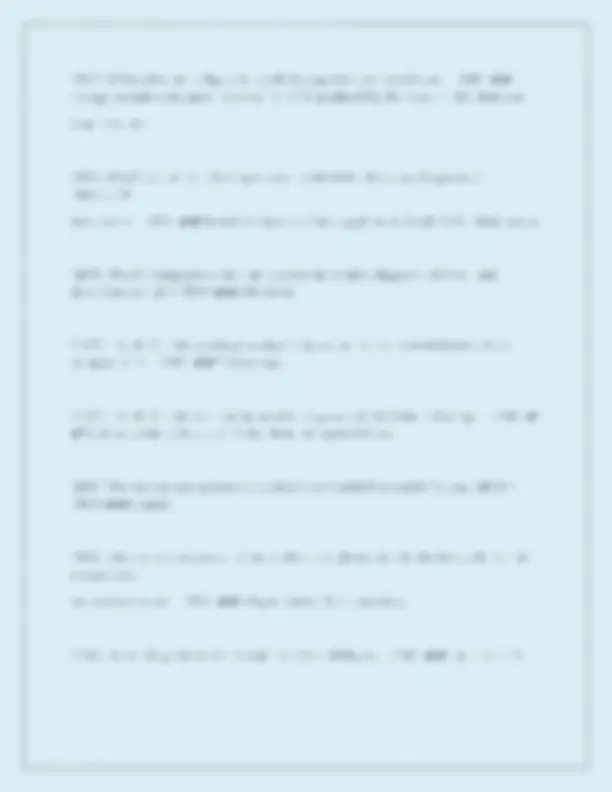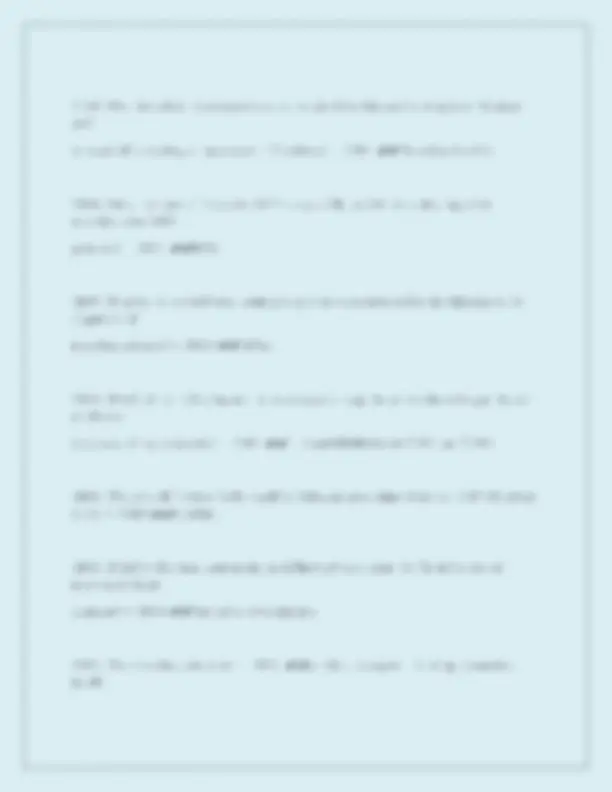Partial preview of the text
Download Microbiology Questions and Answers: A Comprehensive Review and more Exams Microbiology in PDF only on Docsity!
(401) What is the causative agent of Lyme discasc? — ANS-WWBorrclia burgdorferi. (401) What is the preferred method for diagnosing relapsing fever? — ANS-Vv Direct microscopic observation. 401) What is the preferred method for diagnosing I.yme disease? — ANS-WW Indirect immunofluoreseence assay. (402) The spirochetes of T. pallidum are - ANS-WW6 to 20 #m in length with 8 to 15 spirals. (402) Which one of the following is the ctiological agent of venereal syphilis? — ANS— Vv Treponema pallidum subspecies pallidum. (402) During secondary syphilis, the most logical place ta isalate Treponema pallidum would be the — ANS-WwW skin lesions that make up the rash. (403) The spirochetes of l.eptospira are —- ANS-WW6 to 12 #m in Jength with 12 to 18 spirals, (403) A peculiar characteristic of Leptospira is the fact that terminal one-third of the organism is — ANS-WW# flexible and hook shaped. (403) Which serotype of I.cptospira causes a severe illness referred to as Weil's disease, icteric leptospirasis, or infectious jaundice? — ANS-WW Leptospira interrogans scrovar iclerohaemorrhagiae. (403) Which method is considered the most useful strain-spccific test and remains the reference methad for leptospiros: 2 — ANS-We Microscopic agglutination test. (404) Because of their size and genetic make-up, the mollicutes are very particular and for proper growth require which of the following additives to grawth media? - ANS-Vv Cholesterol and yeast extract nucleic acid precursors. (404) Since the mollicutes do not haye a cell wall, they are resistant to - ANS-V¥v 6 lactam, (404) Which Mycoplasma species is associated with NGU? — ANS-WUM. genitalium. (404) On AZ agar and under ideal atmospheric conditions Mycoplasma produces what characteristic colony appearance? — ANS-VWried-cgg, (404) Which microorganism is associated with stillborn infants and shows a correlation between colonization and fetal morbidity? - ANS-WWL., urcalyticum, (407) What is the standard by which all virology procedures are measured? — ANS— Vv Isolation and identification in cell culture. (407) Viral infections elicit immune responses directed against which antigens? — ANS-WW Core proteins, envelope proteins, glycoprotein spikes. (407) Why is it necessary to obtain paired scrum specimens two or three weeks apart in diagnosing a viral infection? - ANS-WW Antibodies are usually not formed during the early phase of the disease, and the first specimen provides a base line for the sccand in testing antibody levels. (407) Most specimens for viral analysis should be frozen at a temperature of — ANS— vv-70 CC. (407) When shipping specimens for the isolation of cytomegalovirus and varicella virus, the contents should be — ANS-WW rapidly frozen, (408) Salety in the mycobacteriology laboratory is important because many of the techniques employed have the potential for creating hazardous acrosols of infectious — ANS-v¥w droplet nuclei. (408) As a safety measure, what solution is the disinfectant for cleaning the laboratory following mycobacteria processing? — ANS-WW0.5 percent sodium hypochlorite. (408) What biosafety level practices are required for labs performing identification and susceptibility testing of mycobacterial isolates? - ANS-WwW Biosafety level 3. (408) Direct smears of feces for AB is especially useful for evaluating what mycobacteria AIDS patients? — ANS-WYMAC, (408) What is the second most common specimen encountered in the laboratory far diagnosis of mycobacterioses? — ANS-WWvLrine, (408) Which of the following are the most popular egg—based media and agar—based media for recoyery of mycobacteria? - ANS-WWL—J and Middlebrook 7H10 and 7H11. (409) The only difference in the modified Kinyoun procedure from the ZichI-Neclsen is the — ANS-WU mordant. (409) Which is the most commonly used fluorochrome stain for identification of mycobacteria on a smear? — ANS-WWAuramine O-rodamine, (410) The Mycobacterium are — ANS-WWacrobic, nonspore—forming, nonmotile bacilli (413) Differentiation of ycast and various specics of Candida, identification of C. albicans can be accomplished using —- ANS-WW cornmeal agar with Tween 80. (413) Systemic mycoses are deep-seated infections that may spread throughout the bedy but primarily begin in the —- ANS-WW lung. (413) The following are advantages ol culture tubes over Petri dishes for fungus cultures except — ANS-vWW better aeration of the cultures, (414) Me limited to — ANS-WWrate of growth, texture, and pigmentation, scopic examination of fungus growth characteristics includes but is not (414) Probably the most widely used of all wet mounts is - ANS-~WWv potassium hydroxide, (414) Before collecting skin scrapings for a KOH mount, the lesion area is thoroughly washed with 70 percent alcohal to — ANS-WW remove dirt particles, bacteria, and medications, (414) The India ink wet mount reveals the encapsulated budding or non—-budding blastasporcs of — ANS-WW Cryptococcus neoformans, 













